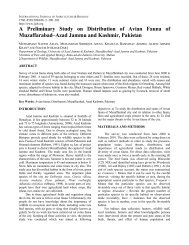Distribution of Freshwater Turtles in Punjab, Pakistan - the Wildlife of ...
Distribution of Freshwater Turtles in Punjab, Pakistan - the Wildlife of ...
Distribution of Freshwater Turtles in Punjab, Pakistan - the Wildlife of ...
You also want an ePaper? Increase the reach of your titles
YUMPU automatically turns print PDFs into web optimized ePapers that Google loves.
Muhammad Akbar, Muhammad Mushtaq-ul-Hassan , Zaib –u-Nisa 145<br />
The most abundant species found was<br />
Kachuga smithi (43.62%) followed by Kachuga<br />
tecta (42.06%). The status <strong>of</strong> Hardella thurgi<br />
and Chitra <strong>in</strong>dica was rare (0.88% and 0.54%,<br />
respectively), whereas <strong>the</strong> status <strong>of</strong><br />
Geoclemys hamiltonii (1.76%) Aspederates<br />
hurum (3.09%) and Lissemys punciata (1.50%)<br />
frequent. Aspederates gangeticus was<br />
common (6.55%). Ofall <strong>the</strong> sites sampled,<br />
<strong>the</strong> breatest numbers and species diversity<br />
was recorded at Head Trimmu (35.09% <strong>of</strong> all<br />
captures) belong<strong>in</strong>g to seven different<br />
species. It is <strong>the</strong> place where two rivers i.e.,<br />
Chenab and Jhelum jo<strong>in</strong> toge<strong>the</strong>r. Maximum<br />
population was recorded <strong>in</strong> Rangpur canal,<br />
which flows from Head Trimmu (2.15%)<br />
(Table 1).<br />
Khan (1999) reported <strong>the</strong> distribution <strong>of</strong><br />
Agrionemys horsfedii <strong>in</strong> Balochistan and not<br />
<strong>in</strong> <strong>Punjab</strong>. Dur<strong>in</strong>g <strong>the</strong> present study it was<br />
aga<strong>in</strong> not recorded <strong>in</strong> <strong>the</strong> <strong>Punjab</strong>. Suwelo<br />
(2001) reported that <strong>the</strong> tortoises, terrap<strong>in</strong>s<br />
and turtles <strong>of</strong> Sou<strong>the</strong>ast Asia have been<br />
harvested from <strong>the</strong> wild for a wide range <strong>of</strong><br />
purposes, primarily for food and traditional<br />
Ch<strong>in</strong>ese medic<strong>in</strong>e, but also for pets and to<br />
release <strong>in</strong> Buddhist sites <strong>in</strong> temples. Jetk<strong>in</strong>s<br />
(1995) reported that <strong>in</strong> recent years <strong>the</strong> trade<br />
has escalated and changed dramatically.<br />
Once predom<strong>in</strong>antly for local consumption,<br />
<strong>the</strong> harvest is now motivated by<br />
<strong>in</strong>ternational demand, primarily <strong>in</strong> East Asia<br />
and particularly ma<strong>in</strong>land Ch<strong>in</strong>a. A<br />
dramatic <strong>in</strong>crease <strong>in</strong> exports to Ma<strong>in</strong>land<br />
Ch<strong>in</strong>a dates from <strong>the</strong> time when <strong>the</strong> Ch<strong>in</strong>ese<br />
currency became convertible.<br />
Dur<strong>in</strong>g our study some threats to turtles<br />
population was also recorded which are<br />
given below <strong>in</strong> order <strong>of</strong> <strong>the</strong>ir magnitude.<br />
1. <strong>Freshwater</strong> turtles do not have any<br />
legal protection coverage through any<br />
prov<strong>in</strong>cial Act; <strong>the</strong>refore, <strong>the</strong>y are be<strong>in</strong>g<br />
captured <strong>in</strong> thousands for supply to<br />
foreigners liv<strong>in</strong>g <strong>in</strong> <strong>Pakistan</strong> and to illegal<br />
export for supply to abroad. Reports <strong>of</strong><br />
captur<strong>in</strong>g turtles on large scale were<br />
received from Chashma Barrage, Taunsa<br />
Barrage, Head Qadirabad, Head Rasool,<br />
Head Trimmu, Head Balloki and Ch<strong>in</strong>iot<br />
area.<br />
2. Fishermen also capture turtles<br />
dur<strong>in</strong>g fish<strong>in</strong>g with nets and angl<strong>in</strong>g. Some<br />
turtles are accidentally killed with nets,<br />
whereas some fishermen considered <strong>the</strong>m<br />
<strong>the</strong> enemies <strong>of</strong> fish, <strong>the</strong>refore, <strong>the</strong>y kill <strong>the</strong><br />
captured turtles to save <strong>the</strong>ir fish. Dur<strong>in</strong>g<br />
<strong>the</strong> study 11 dead bodies <strong>of</strong> Kachuga smithi, 5<br />
<strong>of</strong> K. tecta, 32 <strong>of</strong> Geoclemys hamiltanii and 4 <strong>of</strong><br />
Aspederates gangeticus were observed at<br />
Indus riverbank near Kundian.<br />
3. Dogs were observed wonder<strong>in</strong>g<br />
extensively dur<strong>in</strong>g canal closure <strong>in</strong> search <strong>of</strong><br />
food. These dogs eat dead fish, trapped fish<br />
and turtles <strong>in</strong> shallow water. Dead bodies <strong>of</strong><br />
spotted pond turtles and Indian s<strong>of</strong>t-shell<br />
turtles were observed which were be<strong>in</strong>g<br />
eaten by such dogs.<br />
4. Dur<strong>in</strong>g fish captur<strong>in</strong>g operations by<br />
local peoples turtles are also captured and<br />
occasionally killed.<br />
5. Hibernated turtles are ei<strong>the</strong>r killed<br />
<strong>of</strong> removed from <strong>the</strong>ir natural habitat and<br />
shifted with silt where <strong>the</strong>ir lives are on risk<br />
dur<strong>in</strong>g de-silt<strong>in</strong>g <strong>of</strong> canals.<br />
6. Runn<strong>in</strong>g water ma<strong>in</strong>ta<strong>in</strong>s body<br />
temperature <strong>of</strong> turtles. <strong>Turtles</strong> face severe<br />
cold condition due to unavailability <strong>of</strong> water<br />
and shortage <strong>of</strong> food which is harmful to<br />
turtles when canals are closed.<br />
It was concluded that freshwater turtles<br />
are a very important natural recourse <strong>of</strong> <strong>the</strong><br />
country, which are be<strong>in</strong>g ignored and<br />
wasted. To manage this situation and<br />
preserve turtle populations <strong>in</strong>to future, it is<br />
necessary to provide legal protection/<br />
coverage immediately under <strong>the</strong> <strong>Punjab</strong><br />
<strong>Wildlife</strong> (Protection, Conservation,<br />
Reservation and Management) Act, 1974,<br />
o<strong>the</strong>rwise this natural resource will be<br />
destroyed by <strong>the</strong> local peoples and species<br />
will ultimately become extent.<br />
REFERENCES<br />
Anonymous (2005), Convention on<br />
International Trade <strong>in</strong> Endangered Species <strong>of</strong><br />
Wild Fauna and Flora, Genera,<br />
Switzerland.<br />
Ernst C.H., Altenburg, R.G.M.and Barbour,<br />
R.W. (2005) <strong>Turtles</strong> <strong>of</strong> <strong>the</strong> World. CDcatalogue.<br />
ETI Information Services Ltd.<br />
Ver. 1.2. Information about, and samples<br />
<strong>of</strong> <strong>the</strong> catalogue are available on http://<br />
www.eti.uva.nl/<strong>Turtles</strong>/<strong>Turtles</strong>.html<br />
Jatk<strong>in</strong>s M.D. (1995) Tortoises and <strong>Freshwater</strong><br />
<strong>Turtles</strong>: <strong>the</strong> trade <strong>in</strong> Sou<strong>the</strong>ast Asia. Traffic<br />
International, U.K.




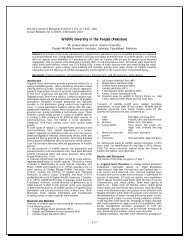
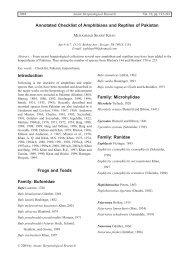

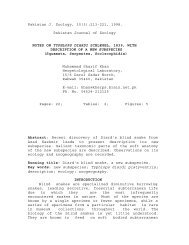


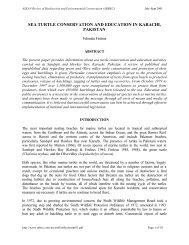
![Dureji (Ovis orientalis [vignei] blanfordi) - Wildlife of Pakistan](https://img.yumpu.com/11814520/1/190x245/dureji-ovis-orientalis-vignei-blanfordi-wildlife-of-pakistan.jpg?quality=85)
